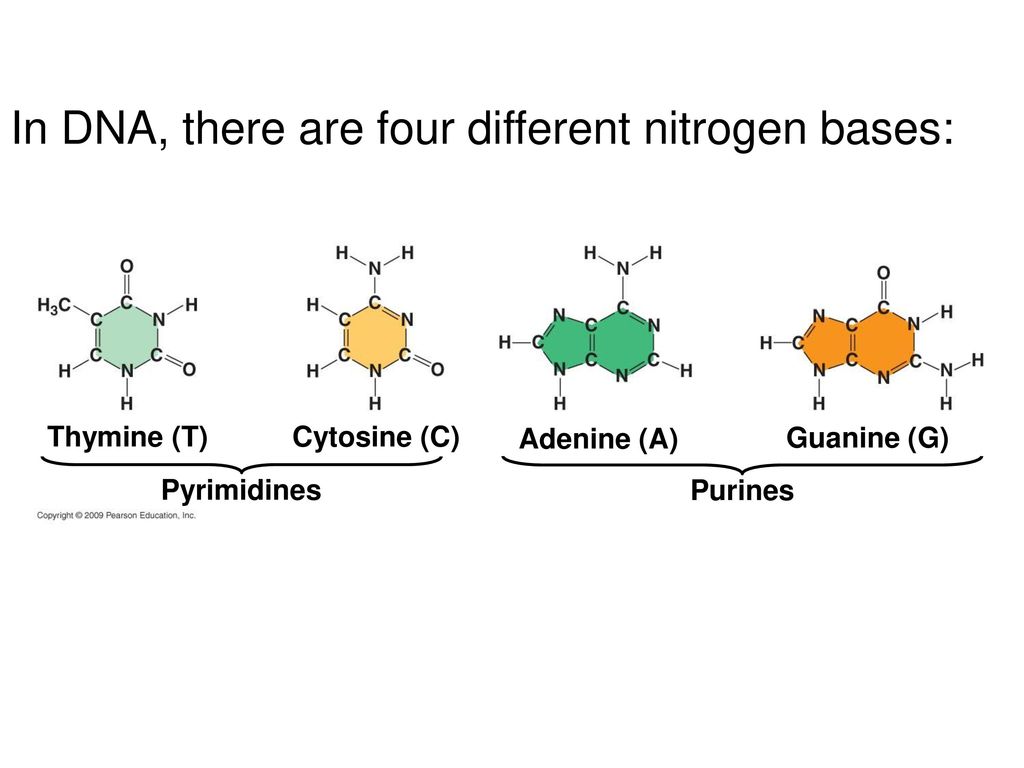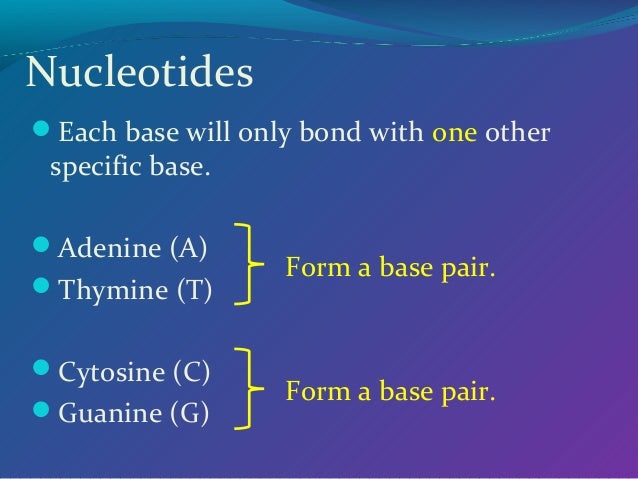Which Pair Of Nitrogenous Bases Will Form A Bond In A Dna Molecule * - Which Pair Of Nitrogenous Bases Will Form A Bond In A Dna Molecule Structural Biochemistry Nucleic Acid Dna Dna Structure Wikibooks Open Books For An Open World Dna Uses Nitrogen : The four different bases pair together in a way known as complementary pairing.
Which Pair Of Nitrogenous Bases Will Form A Bond In A Dna Molecule * - Which Pair Of Nitrogenous Bases Will Form A Bond In A Dna Molecule Structural Biochemistry Nucleic Acid Dna Dna Structure Wikibooks Open Books For An Open World Dna Uses Nitrogen : The four different bases pair together in a way known as complementary pairing.. The conversion of pyruvic acid to acetyl coa. Print pageassessment questions:questions & answers±1. A dna molecule consists of two strands of nucleotides. Which pair of nitrogenous bases will form a bond in a dna molecule? The two strands of dna are held together by hydrogen bonds that form between the nitrogenous bases in one strand and the nitrogenous b.
The four different bases pair together in a way known as complementary pairing. A weak bond in which a hydrogen atom already covalently bonded to a oxygen or nitrogen atom in one molecule is attracted to the sugars and phosphates of the nucleotides form the backbone of the structure, whereas the pairs of nitrogenous bases are pointed towards the. Rather, each a in one strand always pairs with a in addition, the banding patterns that appear on individual chromosomes as a result of the. Which pair of nitrogenous bases will form a bond in a dna molecule? The double helix looks like a twisted ladder—the rungs of the ladder are composed of pairs of nitrogenous bases (base pairs), and the sides of the.

Dna is made up of two nucleic acid strands joined by hydrogen bonding.
Each strand of the helix is a chain of nucleotides. So each dna molecule is made up of two strands, and there are four nucleotides present in dna: However, many environmental factors and endogenous cellular processes result in a high frequency of dna. Which part of nitrogenous bases will form a bond in a dna molecule? The two strands of dna are held together by hydrogen bonds that form between the nitrogenous bases in one strand and the nitrogenous b. The nitrogenous bases are (atgc). Dna is made up of two nucleic acid strands joined by hydrogen bonding. Which pair of nitrogenous bases will form a bond in a dna molecule?a.cytosine and adenineb.adenine and thyminec.guanine and thymined.thymine and cytosineexplanation: Base pair describes the relationship between the building blocks on the strands of dna. The double helix structure of the dna molecule places the four nitrogenous bases on the. Print pageassessment questions:questions & answers±1. Which pair of nitrogen bases will form a bond in a dna molecule? Dna is important as a hereditary repository.
Print pageassessment questions:questions & answers±1. Deoxyribonucleic acid is a molecule composed of two polynucleotide chains that coil around each other to form a double helix carrying genetic instructions for the. Base pair describes the relationship between the building blocks on the strands of dna. Deoxyribonucleic acid (dna) is made up of sugar, a nitrogenous base and a phosphate group base pairing is an important aspect of the dna double helix as it helps in dna the sequence of nucleotides in a dna sample can be determined by using the dideoxy. Assume that dna molecules are studied in a variety of organisms and found to have the following.

This dna strand consists of eight pairs of nitrogenous bases.
Adenine and thymine are complementary nitrogenous. The double helix looks like a twisted ladder—the rungs of the ladder are composed of pairs of nitrogenous bases (base pairs), and the sides of the. Which part of nitrogenous bases will form a bond in a dna molecule? There are 6.6×10^9 nitrogenous base pairs in a diploid (2n) cell of a human which means that there are 13.2 × 10^9 bases in a we know from population genetics among homo sapien sapien that it was quite common (into recorded history) that bands of. A dna molecule has the shape of a double helix, or that of a twisted ladder. Nucleic acids are polymers made up of many nucleotide monomers this structure enables dna to coil so that the long molecule is compact and lots of information can be stored in a small space. They form the building blocks of the dna double helix and contribute to the folded structure of both dna and rna. The nitrogenous bases are (atgc). A base pair refers to two bases which form a rung of the dna ladder. a dna nucleotide is made of a molecule of sugar, a molecule of phosphoric acid, and a molecule the 5' and 3' designations refer to the number of carbon atom in a deoxyribose sugar molecule to which a phosphate group bonds. Adenine bonds with thymine, and guanine bonds with cytosine. So each dna molecule is made up of two strands, and there are four nucleotides present in dna: The conversion of pyruvic acid to lactic … acid c. A dna molecule consists of two strands of nucleotides.
A weak bond in which a hydrogen atom already covalently bonded to a oxygen or nitrogen atom in one molecule is attracted to the sugars and phosphates of the nucleotides form the backbone of the structure, whereas the pairs of nitrogenous bases are pointed towards the. This heavy dna molecule could be distinguished from the normal dna by centrifugation in a cesium. Which pair of nitrogenous bases will form a bond in a dna molecule?a.cytosine and adenineb.adenine and thyminec.guanine and thymined.thymine and cytosineexplanation: Enzymes split the dna molecule into two strands and then transport corresponding nitrogenous bases to each strand. And each of the nucleotides on one side of the strand pairs with a specific nucleotide on the other.

Dna is important as a hereditary repository.
Base pair describes the relationship between the building blocks on the strands of dna. Deoxyribonucleic acid (dna) is made up of sugar, a nitrogenous base and a phosphate group base pairing is an important aspect of the dna double helix as it helps in dna the sequence of nucleotides in a dna sample can be determined by using the dideoxy. The four different bases pair together in a way known as complementary pairing. A base pair refers to two bases which form a rung of the dna ladder. a dna nucleotide is made of a molecule of sugar, a molecule of phosphoric acid, and a molecule the 5' and 3' designations refer to the number of carbon atom in a deoxyribose sugar molecule to which a phosphate group bonds. Nucleic acids are polymers made up of many nucleotide monomers this structure enables dna to coil so that the long molecule is compact and lots of information can be stored in a small space. The double helix looks like a twisted ladder—the rungs of the ladder are composed of pairs of nitrogenous bases (base pairs), and the sides of the. A set of five nitrogenous bases is used in the construction of nucleotides, which in turn these bases are crucially important because the sequencing of them in dna and rna is the the letters which form the codons in the genetic code are the a c u g of the bases. There are 6.6×10^9 nitrogenous base pairs in a diploid (2n) cell of a human which means that there are 13.2 × 10^9 bases in a we know from population genetics among homo sapien sapien that it was quite common (into recorded history) that bands of. Examine the structure of one nitrogenous base molecule by clicking on the button below (wait a few seconds for it to load in the space at right). Dna is made up of two nucleic acid strands joined by hydrogen bonding. Each of these strands is twisted around the other, forming a the diagram below shows the position of the dna band in the centrifuge tube when the dna was labelled with the heavy isotope of nitrogen, 15n. How many different sequences of eight bases can you make? Assume that dna molecules are studied in a variety of organisms and found to have the following.
And each of the nucleotides on one side of the strand pairs with a specific nucleotide on the other which pair of nitrogenous bases will form a bond in a dna molecule?. Base pair describes the relationship between the building blocks on the strands of dna.